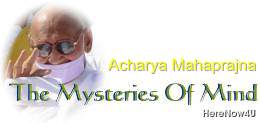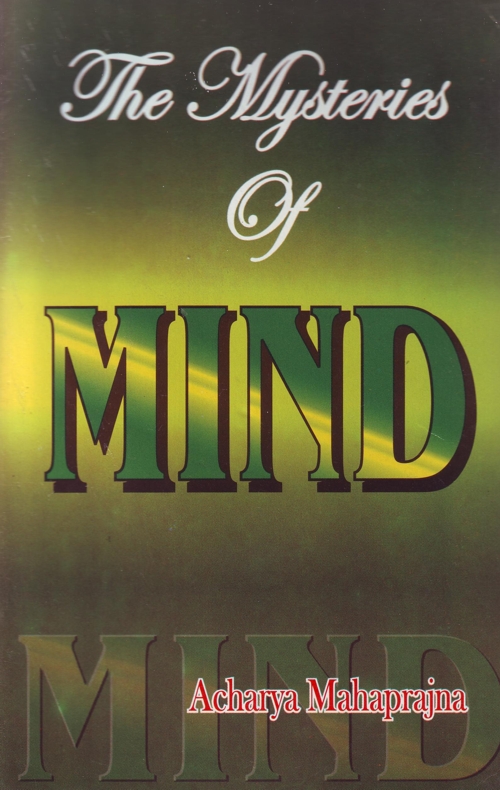
The fundamental principle of Preksa meditation is:
- Let the soul see itself; see your own self.
The system of meditation adopted by Bhagavana Mahavira is based on perception. The soul and the body, although they are basically distinct from each other, are not distinct in practical life. Breath, body, speech and mind are made active by vital energy. The vital force is the diffusion of the taijasa body. The taijasa body is driven by a still subtler body called the karma body. The karma body is made active by the soul. Therefore, perceiving the soul means perceiving the vibrations of breath, body, vital energy and karma.
Kayotsarga is the first step in the process of self-perception. We know the value of the activities of the body but we do not know the value of the inactive body. That is why our muscles become tense. Suspension of the activities of the body is a means of escaping from such tension. When the body is relaxed, breathing becomes slow and the fickleness of the mind is reduced. Kayotsarga serves two purposes - it relives the mind as well as physical and mental diseases.
The second step is freedom from infatuation. It consists in wakefulness, conscious devotion to truth and mental discipline as well as in Bhavakriya or a rational coordination between actions and the mind.
False consciousness and indiscipline make our consciousness dormant. The seeds of all kinds of grief are sown and they sprout when consciousness is dormant.
Freedom from infatuation changes the very course of our life and opens new horizons of joy.
Generally our deeds and our minds do not run parallel to each other. When the body is doing one thing, the mind remains busy in another thing. This results in a depletion of energy. Bhavakriya stops this depletion.
Bhavana is the third step. It increases the vital force and strengthens the will. A strong will does not allow inclination towards material pleasures to become effective. Resolution is the key to all kinds of success.
The fourth step is anupreksa or contemplative assessment of perception. It is a useful exercise in removing, self-negligence and the contamination of the mind by the consequences of social relations and indulgence in material pleasures. lt concentrates the process of thinking on a single object until a state of experience has been arrived at. It develops tolerance and the purity of heart.
Preksa is the fifth step. It activates the body and the centres of consciousness. It enables us to perceive and know the internal structure of the body. Perceiving long breathing improves physical and mental health. It activates the taijasa body and stops the fickleness of the mind. It removes poisons from the body and reveals to the practitioner the subtleties of the mind.
Body perception means watching and understanding the ever-happening changes in the body. It enables the practitioner to come face to face with substance by studying its modifications. It means perceiving the chemical changes in the body and to be convinced that the body and all that is in it are ephemeral. It is the process of proceeding from the perishable to the imperishable. It means watching all physiological happenings and the feeling of pleasure and pain with a dispassionate mind and to make a distinction between the body and the soul.
By perceiving the centres of consciousness we can establish our mastery over them and employ our energy in bringing about chemical changes in the body.
Then comes the perceiving of the ever-happening vibrations in the body, mind and breath. These vibrations can be increased by means of subtle prana and reduced and stopped by restraining the flow of vital energy. Counter vibrations can also be produced by means of bhavana or suggestion. Both purity of thoughts and thoughtlessness are useful in perceptive meditation. Change in the frequencies of breathing and its vibration brings about a spiritual revolution in us, which brings human relations on a new footing.
Preksa meditation is the means of developing four states of the mind.
- Wakefulness
- Bhavana
- Thinking
- Perception.
False consciousness and the fickleness of the mind and body are caused by our lack of willing interest in truth and moral discipline. As our existence undergoes continuous modifications, we become deluded by external agencies, suggestion and speech and change ourselves in the light of these influences. Attachments and aversions rise in our minds if our mental states are favourable to them. And this applies to our thoughts also. Our thoughts determine our perceptions. When we become involved in sense objects our feeling, thinking and perception also become involved in them. This is the main cause of all problems and miseries.
 Acharya Mahaprajna
Acharya Mahaprajna

